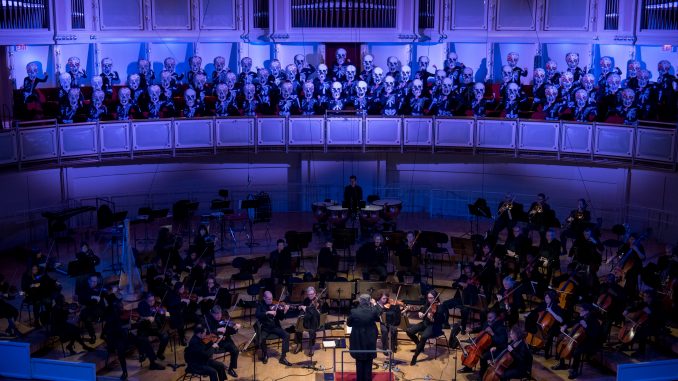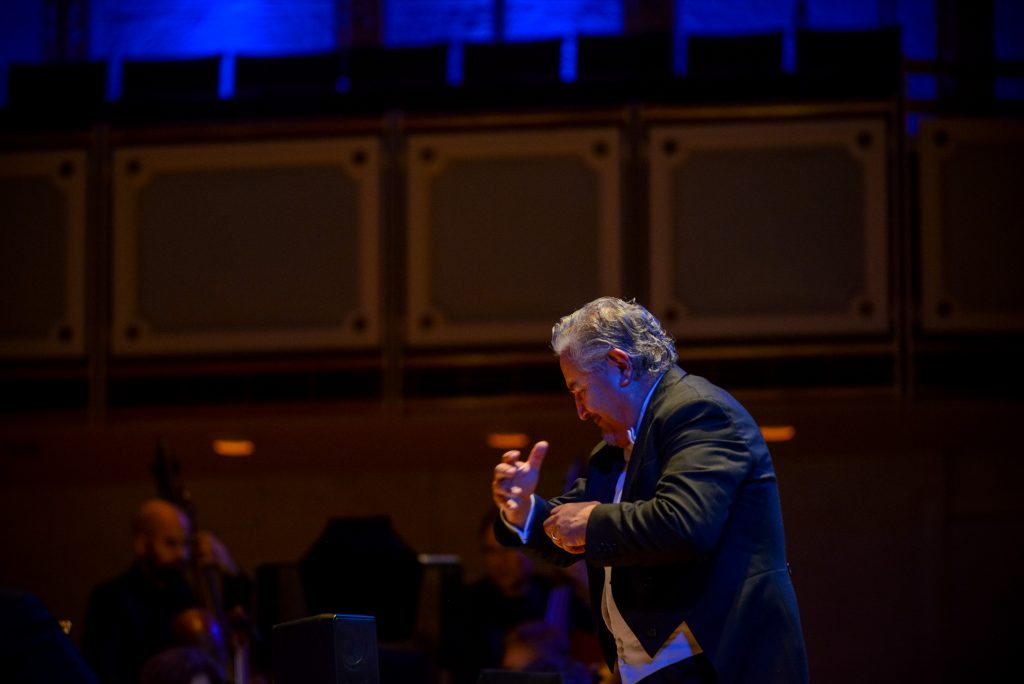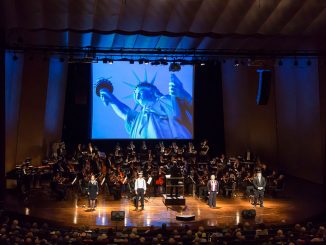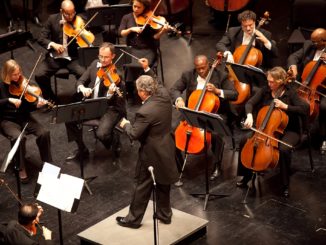
On November 6th, 2017, the Chicago Sinfonietta, under the baton of Special Guest Conductor Hector Guzman, and Cuerdas Clasicas along with the Roosevelt University Conservatory Choirs and Alumni Chorus put on a delightful concert entitled Regresar for Día de los Muertos at Symphony Center, 220 S. Michigan, Chicago. The choristers were outfitted with spectacular costumes and masks by NewMoon Chicago and directed by Dr. Cheryl Frazes Hill and Mark Crayton.
The program consisted of:
– Astor Piazzolla/ arr. Eugenio Castillo Libertango
Recorded and published in 1974 in Milan, the title is a metaphor for Piazzola’s break from Classical Tango to Tango Nuevo, or new tango. The song begins rapidly and continues in a faster pace than other tangos; not really smooth enough for the traditional dance, for which it is too frantic. It is, however, considered to be one of the best, and certainly one of the most popular concert tangos.
As arranged by Castillo, a friend and classmate of Guzman, who was in the audience, it was propulsive, provoking, dynamic, and relentlessly suggestive.

-Silvestre Revueltas Redes, 1936
Part I: The Fisherman, The Child’s Funeral, Setting Out to Fish
Part II: The Fight, The Return of the Fishermen with Their Dead Friend
Redes (Nets) was the first of Revueltas’ film scores. The movie focused on the poor Veracruz fishing community and the score, described by Guzman as “outstanding”, consists of 2 parts. The first suite begins with music about the strife of the fishermen, continues through a lament at the funeral of a child and ends with a festive fishing party. Part 2 begins with the music of a fight scene, continues through another dirge, and ends with fishermen returning with the body of a dead friend.
Mexican poet Octavio Paz wrote that Revueltas’ music is founded or based upon a special ingredient, “That element, better and more pure . . . is his deep-felt but also joyful concern for man, animal, and things. It is the profound empathy with his surrounding which makes the works of this man, so naked, so defenseless, so hurt by the heavens and the people, more significant than those of many of his contemporaries.”
Revueltas’ score reflects a keen sensitivity to the music of the people- light, joyous melodies amid the sad and ominous tones- and a direct bold realism. The Sinfonietta, deftly conducted by the restrained enthusiasm of Guzman, produced sensations of woe drenched in sonority enlivened by moments of lyrical sweetness.
– Wolfgang Amadeus Mozart Requiem, 1791
Dies Irae
Rex Tremendae
Confutatis/Lacrymosa
Hostias
Sanctus
Lux Aeterna/Cum Sanctis
In 1791, Count Franz von Walsegg commissioned Mozart to write a Requiem Mass, but Mozart died before completing the work. He left behind only outlines for a great deal of the piece. Scholars have concluded that the last bars he ever wrote were the first eight of the seventh movement, “Lacrimosa.” Subsequent to his death, his student Franz Xaver Süssmayr finished the most familiar version.
The Choirs and Chorus sang on the balcony above and behind the Sinfonietta. They appeared in black full bodystocking costumes accented in white. Bathed in multiply colored light and wielding in unison the extraordinarily creative masks- with blank faces, zombie heads and moveable lips- their voices soared above the Sinfonietta and out into the bemused audience. Together, conductors, vocalists and Orchestra captured the quiet beauty, deep pathos and emotional anger of this piece. Sometimes dark and furious, sometimes soaring and energetic, it was a powerful and finally uplifting proclamation.
– Edvard Grieg Aase’s Death, Peer Gynt Suite No. 1, 1875
The Norwegian playwright Henrik Ibsen authored the play Peer Gynt that features a legendary soundtrack by Ibsen’s countryman Edvard Grieg. Aase’s Death is a beautiful song due to the slow ascending chords that open the piece, a quickly repeated pattern in a higher key, followed by that same pattern in reverse, descending chromatically. The melody invites one to focus on either a herald of death or a climb to heaven.

-Ramiro Cortés Marila, Un Cielo Para Ti, Jalisco de Mis Amores, 2010
Cortés is said to be the 1st Hispanic American to have achieved international recognition in classical music. His compositions include vocal, keyboard, chamber and orchestral works and works for film, stage and band.
These 3 sparkling and lively tunes were performed with observable joy and pride by the musicians/troubadors of Cuerdas Clásicas, on lutes, guitars and bass, accompanied on the first 2 by the strings of the Sinfonietta. The music, in the style of Mexican folklore, is pure, delicate, melodic and transporting- also weepingly sentimental.
-José Pablo Moncayo Huapango, 1941
Moncayo’s student José Antonio Alcarez has provided a quote from Moncayo about his creation of this piece, commonly regarded as the 2nd Mexican National Anthem:
“Blas Galindo and I went to Alvarado, one of the places where folkloric music is preserved in its most pure form; we were collecting melodies, rhythms and instrumentations during several days. The transcription of it was very difficult because the huapangueros (musicians) never sang the same melody twice in the same way. When I came back to Mexico, I showed the collected material to Candelario Huízar; Huízar gave me a piece of advice that I will always be grateful for: ‘Expose the material first in the same way you heard it and develop it later according to your own thought.’ And I did it, and the result is almost satisfactory for me.”
The title comes from a dance performed on a wooden plank. The Sinfonietta performed it with a rhythmically playful and flexible intonation, yet withal imbued with a grandeur and pride.
It is easy to see why Maestro Guzman is in demand internationally as a conductor and recitalist. His enthusiasm, musicianship, control of rhythm and graciousness to the musicians were on display throughout this concert. The Chicago Sinfonietta, the most diverse orchestra in the world, was likewise in fine form and delighted the sold-out audience.

For information and tickets to all the fine concerts of the Chicago Sinfonietta, go to www.chicagosinfonietta.org
All photos by Chris Ocken




Be the first to comment